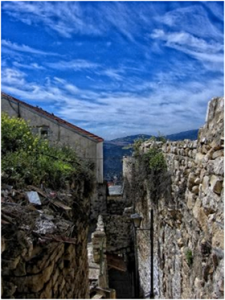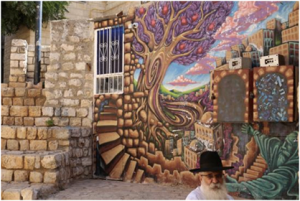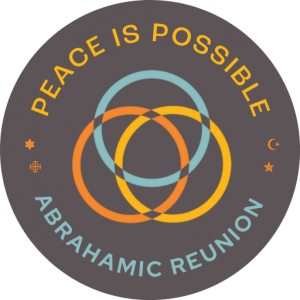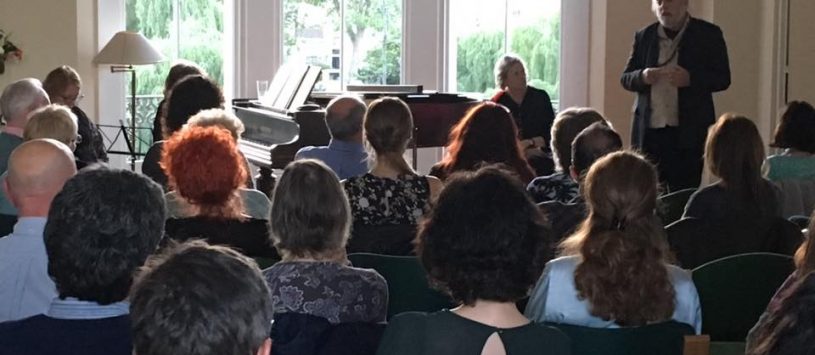
Blogs from Dr. Anna Less, Co-Founder and International Executive Director of the Abrahamic Reunion, May 14th – June 6th 2017
Preface
This is the third speaking tour to the UK that The Abrahamic Reunion’s International Executive Directors, Dr. Anna Less and Ghassan Manasra, have done on behalf of the Abrahamic Reunion. Anna’s husband David Less, another founding member and Chairman of the Board, accompanied them on part of this tour to hold a fundraiser in London for the Abrahamic Reunion, before leaving for Germany, where he met with the Abrahamic Reunion’s German board.While in London Anna, Ghassan and David worked with the AR UK team, founded by the AR UK board members Amanda and Michael Kenton.
Michael and Amanda did a brilliant job of organizing this tour, which included speaking engagements at a prison, a synagogue, an interview on BBC radio, and many other exciting events coinciding with the beginning of Ramadan.
The blogs represent the views and experiences of Dr. Less as she traveled through the UK with Ghassan and her husband on a trip that represents a significant step forward in creating a network of Abrahamic Reunion peace-builders in the UK.
The first blog recounts aspects of David and Anna’s interview with Clare Balding at the BBC 2, where Clare hosts a live weekly Sunday morning program from 7 – 9 AM that focuses on various faith issues, called Good Morning Sunday.
Blog 1: BBC2 Radio Interview

In the interview we begin by describing our work in the Holy Land; we talk about building bridges and connections, we describe our Iftar dinners, the text study groups, and our interfaith prayer gatherings in Jerusalem. We also talk about our upcoming fundraisers and programs. It feels like word about the AR’s work is really getting out to the UK, work that can offer so much to this country
David tells the following story:
Many years ago I was privileged to be mentored by a very great teacher who believed in the principle of harmony and love as the very essence of religion. He taught me to always look at life through the lens of two words: “what if?”
In my five decades of work, with religious leaders from many of our world’s faiths, I have often asked this question regarding the differences and variations of beliefs in religions.
What if we could honor the basic tenets, customs and traditions of any religion and yet pierce the veils of separation and find the living core common to all.
For the first time in our known history we are developing a global civilization. By knowing the basic practices and beliefs of the other we can become inwardly global.
Dialogue and understanding emerge naturally, when respect and knowledge are seminal.
Our group, the Abrahamic Reunion, has brought thousands of the inheritors of Abraham’s vision together to experience in houses of worship, in eating together, in sharing prayers together, an opportunity to rekindle our deeply rooted generations old memory of the family of Abraham.
What if we really lived that memory?
He concludes by reading Rumi’s poem
“Out beyond ideas of wrongdoing and right doing there is a field. I’ll meet you there. When the soul lies down in that grass the world is too full to talk about.” Rumi

Click here to listen to the BBC 2’s “moment of Reflection with The Reverend David Less”
Blog 2: After the Manchester Bombing by Dr Anna Less

Memorial in Manchester for the victims of the Manchester Bombing
London 5/22/17 After the Manchester Bombing
It is May 22 and the horrifying news comes in from Manchester.
There has been a suicide bombing at an Ariana Grande concert attended by mostly young teenage girls and their families.
Police release pictures from a security camera of Salman Abedi the 22 year old suicide bomber sauntering into the concert in his £150 Nike trainers and trendy jacket on the night of the attack. A short time later Abedi killed 22 people and injured 119 when he detonated a bomb after the concert.
Isil calls on followers to rise up in ‘war’ on infidels in the West and
eight men are in custody “on suspicion of offences contrary to the Terrorism Act”
A few days have passed and the terror threat has been downgraded to severe and police say the investigation is ‘making good progress’ as they appeal for more information from the public.
We stay in Sheperd’s Bush, a diverse, but predominately Muslim neighborhood. It has many Muslim restaurants, Arabic writing on the shop signs, and a Mosque within walking distance of our apartment. It is common to see women in full niqab and men in kaftans shopping in the markets.
We talk to the Muslims we meet in our neighborhood, and in the shops and in the restaurants and in the trains. We talk to our Muslim Uber drivers, our Muslim landlord, we talk to the Muslims foundation leaders we meet. We talk to Muslims from Somolia, Iran, Pakistan, Syria, Turkey, Uganda, and Ethiopia.
They have different theories, “Perhaps he wanted to kill himself, but he did not want to die alone”, “Perhaps someone planned it who is against Muslims” “People are under so much stress they are just crazy”
It is clear the Muslims we talk to are as baffled as we are, and even more frightened. Some of them are so afraid they do not even want to talk about it. They also do not regard themselves as safe.
We ask the ones who have teenagers what the mosques are doing to protect them and to teach them.
Ghassan admits that he was worried about going to the mosque for Jummah prayers after the attack. He doesn’t know what to expect. His history of attacks from radicals makes these events come even closer.
Is the mosque safe? Will the public attack the mosque? Could some one bomb the mosque? Will there be radicals in the mosque? Ramadan is coming the next day.
He decides not to go to our local neighborhood mosque, but instead goes to the large Central Mosque.
The police are there. The London police carry guns now. Amanda reminds me that until recently the London police didn’t even carry guns.
When we meet up with Ghassan in a coffee shop later, we sit and talk over coffee and lemonade, and he is palpably relieved after going to the mosque. He said that when he first entered the mosque a number of the congregants were dressed as strict orthodox Salafis, which generally indicates they uphold a very fundamentalist interpretation of Islam, but after the prayers, when the Imam spoke, Ghassan came to understand that the Imam was advocating a very moderate perspective. The Imam told the congregation that they are members of the UK society and need to protect their home and their fellow countrymen and come forward if they knew any thing. He explained that the people who are most damaged by these types of acts are the Muslim community itself and he prepared them to enter the sacred month of Ramadan, which is a time of deep inner reflection for all Muslims.
After we talk we prepare to enter the train for our next meeting. It is rush hour and I realize I feel nervous about getting on the train, there is no security or metal scanners, features that I have come to expect in public places in much of the world, and as we squeeze on board our bodies are pressed against our fellow passengers. My heart begins to pound as I anxiously scan people with backpacks and look into the faces of young men, as the train carrying thousands of passengers zooms beneath metropolitan London, I wonder why choose a venue with young teenage girls as a target. Why? I close my eyes and pray for those children and their families and I remember words of the Sura al Fatiha and send it out as a prayer to all.
SURAH AL-FATIHA
In the name of Allah, Most Gracious, Most Merciful.
Praise be to Allah, the Cherisher and Sustainer of the worlds;
Most Gracious, Most Merciful;
Master of the Day of Judgment.
Thee do we worship, and Thine aid we seek.
Show us the straight way,
The way of those on whom Thou hast bestowed Thy Grace, those whose (portion) is not wrath, and who go not astray.
Blog 3: Presenting at Grendon Therapeutic Prison Near London

Dear Friends,
Last year when we came to England Ghassan and I spoke at a Quaker meeting. One of the attending Quaker ministers there, Yvonne Dixon was so moved by our talk that this year she arranged for David, Ghassan and I to speak at Grendon Prison where she is a chaplain.
Grendon Prison is the United Kingdom’s only therapeutic prison community for the treatment of serious sex offenders and violent criminals.
Below are some excerpts from an article about typical inmates at Grendon Prison that I read to prepare myself for my experience there. The article is about “Adam” and “Eddie” (not their real names).
“Hello, I’m Adam. I’m serving life for murder. I killed my daughter.” (His daughter was about to turn four when he killed her).
I wasn’t expecting that, I was prepared for “I killed somebody”, or “I killed another gang member”, or “I killed my best friend because he was sleeping with my wife”, even. But this was something different. For the next few minutes I couldn’t think about anything else. His words echoed round my head as he carried on talking, telling me how much time he’d already served (eight years) and how much time he still had to serve (seven years).
“But the thing is”, he said, “I’m having to come to terms with what I’ve done because I have to talk about it every day with the guys here. I have to talk about my feelings and re-live the events leading up to the moment it happened.
“It’s what I signed up for. I knew the only way I was going to get through this was to come to Grendon (prison) and try and turn my life around by facing my demons.”
So what is next for Adam? A man who killed his own child in revenge for his wife’s infidelity?
“I’m going to be taking part in psycho-drama soon”, he tells me, “which is where we act out the crime with the other inmates. I’ll have to go over the night I killed my daughter in detail, not only from my perspective but from my wife’s and my daughter’s.”
He looks absolutely terrified at the prospect.
At the end of his trial the judge told Adam: “You will have to live with what you have done for the rest of your life.”
But by coming to Grendon it’s even harder than that. He has to re-live it every day.
“Eddie”, a former gang member from Birmingham, is in for murder.
“All I had ever known was how to be part of a gang”, he said. “It was normal for me to have a gun in my hand. It was normal to be violent. When I got sent to prison my mates were already there.
“Coming here is probably the hardest thing I’ve ever done. (Here) You’re asked to talk about your feelings – something you never do in a gang. You’ve got to accept people who are different, and you have to control your anger. If you’re violent you’re out. It’s the complete opposite of being in a gang.”
This is the story that most of the inmates tell. The decision to come to Grendon is not an easy one.
To us on the outside it seems like a no-brainer: a high security jail surrounded by violent and desperate men or a prison where violence isn’t tolerated, you can wear your own clothes, and take part in therapy? But we haven’t lived the lives they have. *
 As we drive through the loops of barbed wire to enter the prison grounds, Yvonne explains that the Grendon Prison grounds also house the Spring Hill Prison, which was used during the Second World War as a radio transmission centre for Special Operations Executive . I am stunned to realize that my spiritual teacher’s sister Noor Inayat Khan, who was trained as a radio operator sent her radio transmissions to these very grounds throughout the war. After the war, theses facilities were converted to become the UK’s first open prison. And in recent years the gymnasium here was dedicated to, and named after Noor Inayat Kahn.
As we drive through the loops of barbed wire to enter the prison grounds, Yvonne explains that the Grendon Prison grounds also house the Spring Hill Prison, which was used during the Second World War as a radio transmission centre for Special Operations Executive . I am stunned to realize that my spiritual teacher’s sister Noor Inayat Khan, who was trained as a radio operator sent her radio transmissions to these very grounds throughout the war. After the war, theses facilities were converted to become the UK’s first open prison. And in recent years the gymnasium here was dedicated to, and named after Noor Inayat Kahn.
I feel her hand reaching through time and space to guide this experience as we sign in and enter a chamber where we, and our bags are searched. They confiscate my jump drives and my pack of chewing gum.
“Some one could use it to make an impression of a key,” they explain.
We are escorted through hallways hung with excellent and very detailed artwork done by the prisoners with lots of time.
We enter a large and very cold gymnasium to set up for our presentation. We are told that our program is “very popular” and over 65 inmates have signed up to come. More chairs and benches are brought in. The prison therapists, clergy and staff also want to see what we are presenting.
We are introduced to the prison’s Imam and other clergy members.
As people file in and take their places, I can’t keep myself from trying to identify who is the staff and who are the inmates. Many people in the audience wear religious symbols, necklaces or beards that identify their religious affiliations.
David and Ghassan each speak eloquently about the work of the AR. When Ghassan speaks in Arabic and references the Quran and other Islamic texts, the Imam and various audience members light up and nod. When David speaks from the heart people around the room respond with profound recognition and applause.
I show the power point, and explain our activities, and afterwards there is a question and answer session. The questions are deep and heartfelt, and are followed by refreshments and an opportunity for the audience to speak with us individually.
A young Muslim inmate filled with light introduces him self. He tells us our work of bringing people from insular religious communities to meet with others was so important. He describes how growing up in an insular Muslim community in London had led to his radicalization and ultimately to this destiny.
We were told that in the after math of nine eleven he had murdered someone in retaliation for the media’s portrayal of Muslims, and he has been in prison since that time. I try to feel back through the years to nine eleven and consider what I had experienced in my own life since then and I try to imagine what he had experienced….
He said that in about 5 years perhaps he would released and it was his dream to be able to work with an organization like ours to promote interfaith harmony.
Another man approaching middle age with a long beard introduced himself as having an English, Jewish Mother, and a Muslim, Pakistani father. He shared had been in prison since the age of 17. He didn’t expect to be out soon. He wondered if he could work for the Abrahamic Reunion from within the prison. He said he had good computer skills and this work was exactly what he had been looking to do. He wondered if there was a way he could be of use to us, and to our work.
Others who had been involved in religiously motivated hate crimes came forward to express their support and admiration and share how important they felt our work was.
Chaplains came forward to ask how they and the inmates could learn to start an AR inspired interfaith study program.
As we rode the train home each of us described how profoundly and deeply moved we were by our experience there. We shared that it could potentially be a life altering experience for each of us personally and perhaps for the Abrahamic Reunion in general. We joked about presenting to a “captive audience” but our joking was an attempt to alleviate the profound sense of responsibility that each of us was experiencing as we continued to imagine how the Abrahamic Reunion could serve this community, and as we recognized the potentially far-reaching effects that work could have.
When I arrived home and opened my computer I had inquiries waiting from the directors and chaplains at the prison explaining that ‘radicalization’ in prisons is a very important topic that needs to be addressed and wondering how we could work together in the future.
We are absorbing this.
Blog 4: Preparing for Rabbi Zeller
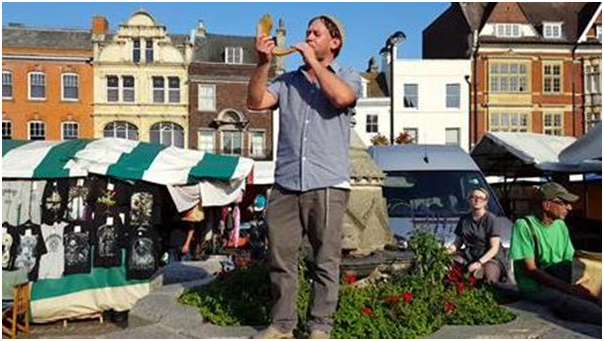
Photo Credits: https://www.thejc.com/community/community-news/chaplain-is-a-big-noise-in-cambridge-1.53662
This week we had to move to a new apartment. The big event we had planned over the next several days was to make a film for the UK foundation leaders who have asked us for a 3-minute video about the Abrahamic Reunion
Determined to stay in a familiar neighborhood, we search the Air B&B ads on the Internet for something close by with good lighting.
We find a Garden Apartment, and put in our payment. We go to the address and we were so happy to realize that not only is it suitable for filming, but it is also only a few blocks walk to the public transportation system.
As the time for our move draws closer, our new landlord doesn’t return our calls. We packed our things and prepare to leave, but we have no key to enter our new flat, and the new tenants are waiting for us to vacate our apartment so they can move in, but we still we have heard nothing.
We stand temporarily homeless on the sidewalk with all our belongings around us, and nowhere to go, while my husband uses his phone to search for a new apartment.
Miraculously he finds an apartment only 10 buildings away that we are able to rent in the last minute!!!
While we carry our bags up the six flights of stairs to our new rooms we eye the sheets of plastic and scaffolding covering half the building and pray that we will be able to shoot the film.
A few days later Jonathon hauls his cameras, lights and tripods up the flights of stairs and we arrange the living room in our new flat for a film shoot. We arrange the window shades, the chairs, the sofa, the microphones, the lights, the tripods and the cameras. We do test runs.
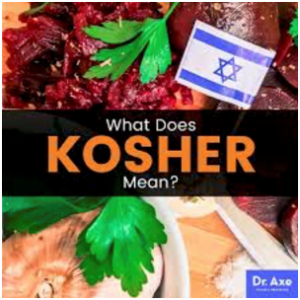 Rabbi Zeller will arrive from Cambridge soon. We have gone out to buy new pans and cooking utensils, paper plates and cups, and plastic cutlery. We have scoured the markets for food with kosher labels*, but only managed to find crackers. We buy dried fruit, water, eggs and nuts, avocados and carrots and celery we haul those up the stairs and then Ghassan reminds me that we don’t have a kosher knife to cut them with, so I put the avocados and new pans and cooking utensils aside and set the carrots and celery out on paper plates whole.
Rabbi Zeller will arrive from Cambridge soon. We have gone out to buy new pans and cooking utensils, paper plates and cups, and plastic cutlery. We have scoured the markets for food with kosher labels*, but only managed to find crackers. We buy dried fruit, water, eggs and nuts, avocados and carrots and celery we haul those up the stairs and then Ghassan reminds me that we don’t have a kosher knife to cut them with, so I put the avocados and new pans and cooking utensils aside and set the carrots and celery out on paper plates whole.
I wonder what do Kosher Jews do? How do they manage to eat?
Rabbi Zeller arrives and says he brought a kosher sandwich with him. He explains there is a Sikh grocer in his area that calls him each month so he can order kosher food to be shipped from Israel.
We sit and eat together and talk. And as Jonathon prepares to film, immediately the construction crew begins working on the wall next to our living room. There is loud banging and hammering and we shake our heads and laugh and carry on. What else can we do?
*For more information on kosher laws, click here
Blog 5: Multi-faith Contemplations of the Elements with Rabbi Mordechai Zeller

Photo Credits: https://www.thejc.com/community/community-news/chaplain-is-a-big-noise-in-cambridge-1.53662
London 6/23/17 with Rabbi Zeller
Rabbi Zeller, Shahabuddin, Ghassan and I talk about what Jewish tradition regards as the Four Holy Cities in the Holy Land.
I had heard that Jerusalem was regarded by the Kabbalists as the city associated with the fire element, and the city of Safed (Tz’fat) was associated with the air element, and that Hebron was associated with the Earth Element, but I did not know what city was associated with the water element, so I asked Rabbi Zeller.
He shared that it was Tiberius.
We shared that in India there is a belief that associates certain cities with certain elements, and the chakras, and we wondered if this same microcosmic macrocosmic model exists within Judaism.
We spent the rest of the day talking about these four cities, the elements they represent, and why these four cities represent these particular elements.
We filmed our dialogue and that film will be available on the Abrahamic Reunion website soon. The next blogs will contain the highlights from our discussion.
Blog 6: Jerusalem and the Fire Element (Part 1/4)
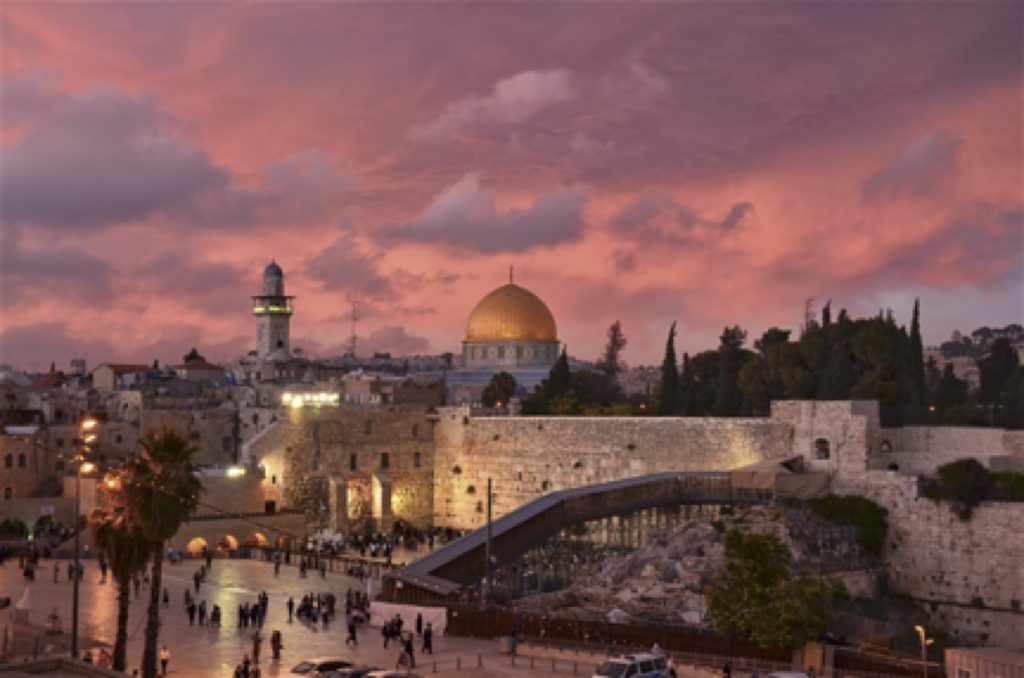 Rabbi Zeller explained that Jerusalem has been the holiest city in Judaism and the spiritual center of the Jewish people since the 10th century BC when that site was chosen by King David to be the location of the Holy Temple. However, interestingly, King David was forbidden from building the temple himself because according to the Bible God said,
Rabbi Zeller explained that Jerusalem has been the holiest city in Judaism and the spiritual center of the Jewish people since the 10th century BC when that site was chosen by King David to be the location of the Holy Temple. However, interestingly, King David was forbidden from building the temple himself because according to the Bible God said,
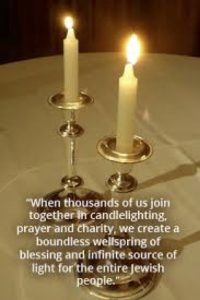 ‘You are not to build a house for my Name, because you are a warrior and have shed blood.’
‘You are not to build a house for my Name, because you are a warrior and have shed blood.’
Rabbi Zeller explains that it was King David’s son, King Solomon who built the first temple. And we collectively speculate that perhaps Jerusalem was associated with the fire element because of the fire element because of the fire sacrifices that were made at the temple.
We have a further discussion about the characteristics of the Fire element and Rabbi Zeller shares that the fire element has a unique quality that allows it to be shared without diminishing itself.
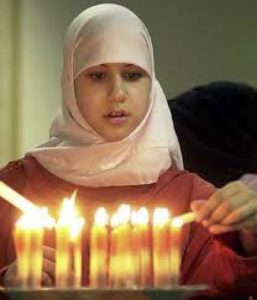 He demonstrates with cup of water and shows us how if we try to share a cup of water, we are only left with a few drops in our cup, but he goes on to say “if we try to share the light from a candle, we can light another candle without ever diminishing our own light.” He thinks this has great metaphysical significance and quotes the prophet Isaiah in Hebrew, and then translates, Jerusalem is supposed, “be a light to all nations.” We all share a moment of “enlightenment” as he describes how the Jews tried to express this metaphysical concept in the structure of the ancient temple in Jerusalem and explained that rather than allowing light to come in through the windows, the ancient temple had special windows designed so that the light would shine out from within the temple.
He demonstrates with cup of water and shows us how if we try to share a cup of water, we are only left with a few drops in our cup, but he goes on to say “if we try to share the light from a candle, we can light another candle without ever diminishing our own light.” He thinks this has great metaphysical significance and quotes the prophet Isaiah in Hebrew, and then translates, Jerusalem is supposed, “be a light to all nations.” We all share a moment of “enlightenment” as he describes how the Jews tried to express this metaphysical concept in the structure of the ancient temple in Jerusalem and explained that rather than allowing light to come in through the windows, the ancient temple had special windows designed so that the light would shine out from within the temple.
Ghassan recites the following verse from the Quran.
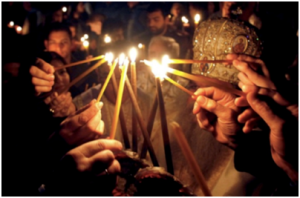 Allah is the Light of the heavens and the earth.
Allah is the Light of the heavens and the earth.
The example of His light is like a niche within which is a lamp,
The lamp is within glass, the glass as if it were a pearly [white] star, Lit from the oil of a blessed olive tree,
Neither of the east nor of the west,
Whose oil would almost glow even if untouched by fire.
Light upon light.
Allah guides to His light whom He wills.
And Allah presents examples for the people,
and Allah is Knowing of all things.
We each described what we knew about the characteristics of the fire element and Shahabuddin and I shared that we had visited temples in India where the same fire had been kept burning for thousands of years.
Blog 7: Hebron and the Earth Element (Part 2/4)
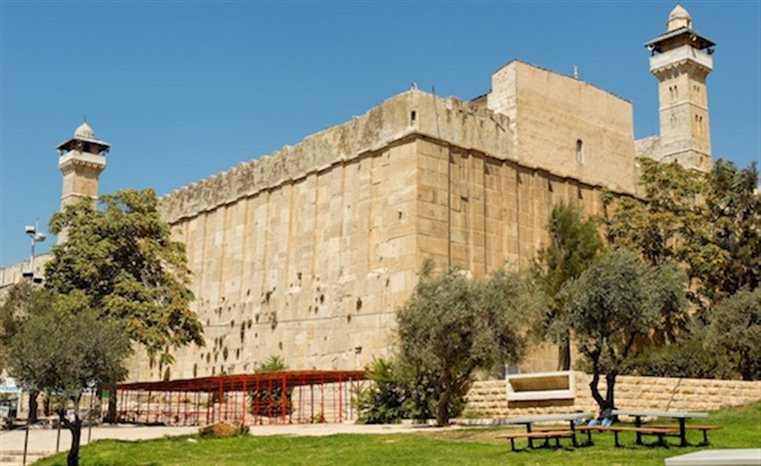 Rabbi Zeller explains that Hebron is associated with the earth element because it was the place where Abraham bought land for the burial place of Sarah. He says this is first time that the bible mentions the buying of land and he thinks it was significant that this land was bought with the intention of being used for a burial. Ultimately Abraham, Sarah, Isaac, Rebecca, Jacob and Leah would all be buried there and Hebron would become the second holiest city for the Jews.
Rabbi Zeller explains that Hebron is associated with the earth element because it was the place where Abraham bought land for the burial place of Sarah. He says this is first time that the bible mentions the buying of land and he thinks it was significant that this land was bought with the intention of being used for a burial. Ultimately Abraham, Sarah, Isaac, Rebecca, Jacob and Leah would all be buried there and Hebron would become the second holiest city for the Jews.
This led to a long discussion about the characteristics of the earth element and its ability to nurture life and how it is the vehicle for dead things to become transformed into living things. Which leads Ghassan to quote Surah Al An’aam from the Quran.
Surely Allah causes the grain and the stone to germinate; He brings forth the living from the dead and He is the bringer forth of the dead from the living; that is Allah! How are you then turned away?
We consider deeply how each of these traditions are connected to the patriarchs, Hebron, and the Earth Element
Blog 8: Tiberias and the Water Element (Part 3/4)
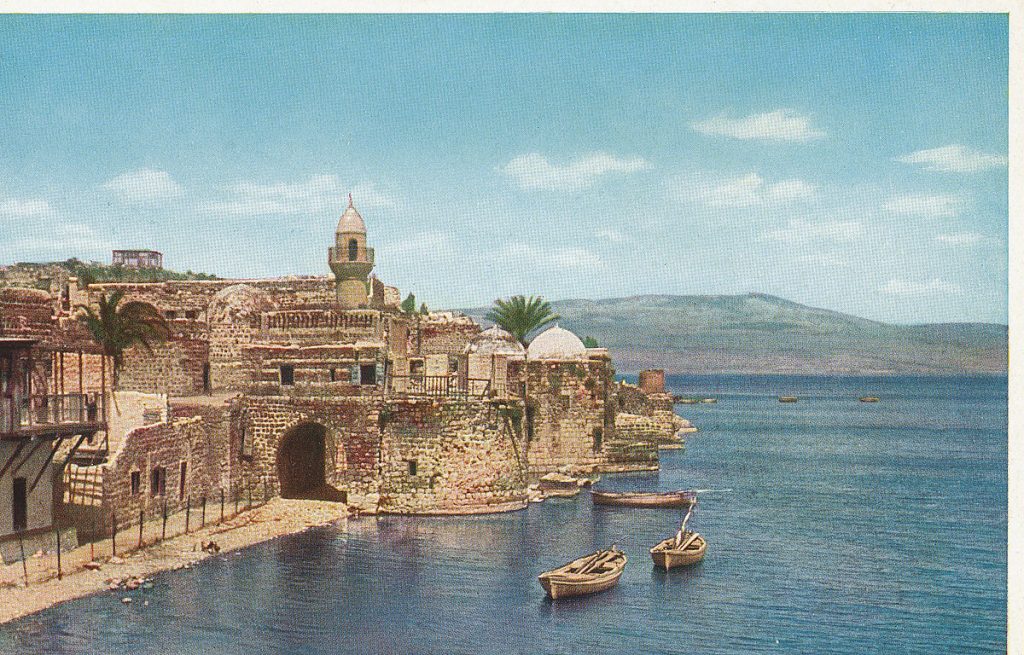 Rabbi Zeller, Ghassan, Shahabuddin, and I continue our discussion:
Rabbi Zeller, Ghassan, Shahabuddin, and I continue our discussion:
After King Herod the Great’s death his three sons divided his kingdom and one of his sons, Herod Antipas, built and named the city of Tiberias, after the Roman Emperor Tiberius.
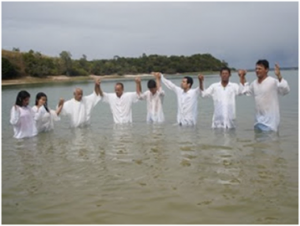
Baptism in the Sea of Galilee (Image Source)
Tiberius sits along the 32-mile long shoreline of the Sea of Galilee (also known as the “Lake of Tiberias,” the “Sea of Gennesaret,” and for Israelis, it is the biblical name the “Kinneret”)
Tiberias is more than 600 feet below sea level, and is the site of 17 natural mineral hot springs. Its waters have welcomed visitors from every part of the world since ancient times.
After his death in 1204, the great Jewish sage Maimonides was buried there.
At the turn of the 20th century, early Zionist pioneers established some of Israel’s first Kibbutzim in this area. After the establishment of the state of Israel, newcomers have flocked to this city and today more than 40,000 people live there.
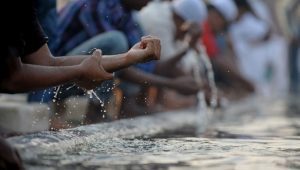
Muslims performing wudu (Image Source)
We have a long dialogue about the nature of the water element as it relates to Islam and Judaism. Islam ascribes the most sacred qualities to water as a life-giving, sustaining, and purifying resource. According to Islam it is the origin of all life on earth, the substance from which God created man and all life:
- “And He it is Who hath created man from water” (Qur’an 25:54).
- “We made from water every living thing”(Qur’an 21:30).
Water is the primary element that existed even before the heavens and the earth did:
- “And it is He who created the heavens and the earth in six days, and his Throne was upon water.” (Qur’an 11:7).
We also discuss the water’s unique ability to be transformed into other states such as ice or vapor and return to its original form. Which leads us to the Jewish prophecy of a returning Messiah.
According to Jewish tradition, the return of the Messiah is related to the water element.
- Jonathan said: When thou seest a generation overwhelmed by many troubles as by a river, await Him. “When the enemy shall come in like a flood, the Spirit of the Lord shall lift up a standard against him;”…. “The Redeemer shall come to Zion.”
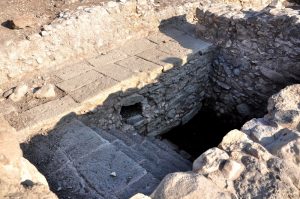
Ancient Jewish mikveh in Magdala, on the Sea of Galilee (Image Source)
Orthodox Jews believe that the redemption will begin in Tiberias with the reinstatement of the Sanhedrin (high court) there. The Messiah will arise from the Lake of Tiberias, enter into the city, and be enthroned in the city of Safed (Tz’fat).
As we pour glasses of water and drink them we consider the sacred use of the water element and its ritual use in Judaism as a Mikvah (a ritual bath performed for purification), in Islam in the practice of Wudu (a type of ritual purification that involves washing parts of the body), and in Christianity in the practice of Baptism. And I silently think of Hindus immersing themselves in the Ganges.
We sip our water and rest in silence.
Blog 9: Safed (Tz’fat) and the Wind Element (Part 4/4)
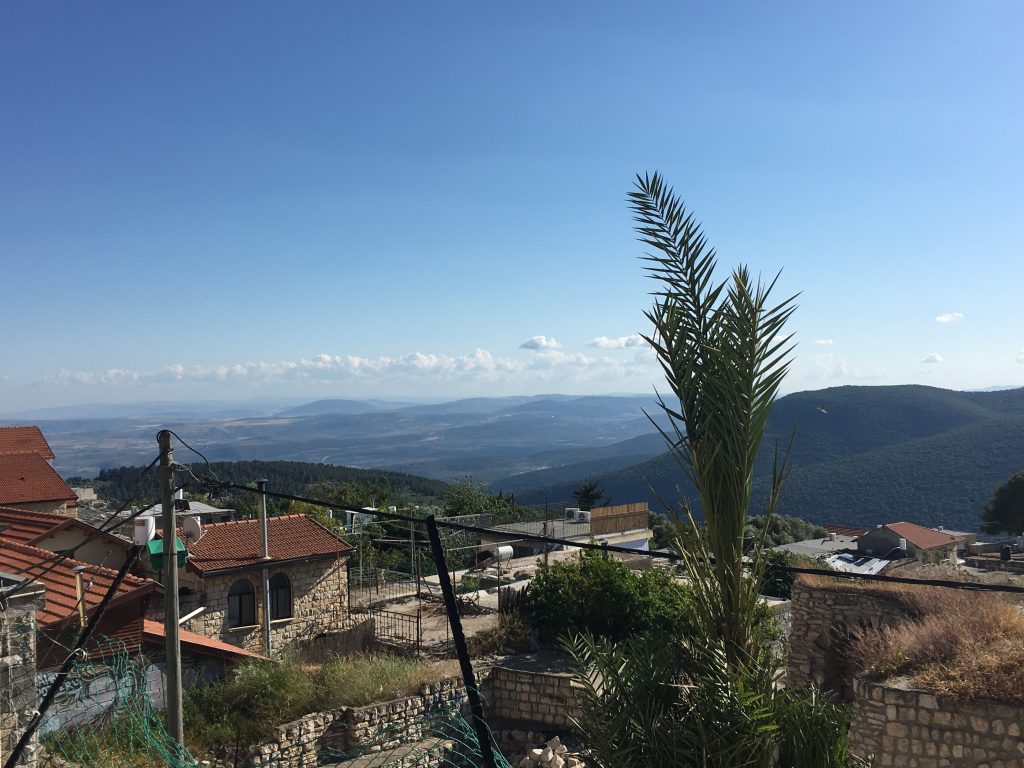 Our dialogue with Rabbi Zeller turns to the topic of the Wind Element and Safed (Tz’fat). Legend has it that the city was founded by a son of Noah after the Great Flood. Located at an elevation of 900 meters (2,953 ft), Safed (Tz’fat) is the highest city in Israel.
Our dialogue with Rabbi Zeller turns to the topic of the Wind Element and Safed (Tz’fat). Legend has it that the city was founded by a son of Noah after the Great Flood. Located at an elevation of 900 meters (2,953 ft), Safed (Tz’fat) is the highest city in Israel.
It has been suggested that Jesus was referring to Safed (Tz’fat) when he spoke about “a city that is set on a hill that cannot be hidden”
The city is also mentioned in the Talmud as one of five elevated spots where fires were lit to announce the New Moon and festivals during the Second Temple period.
After the expulsion of the Jews from Spain in 1492, many prominent rabbis found their way to Safed (Tz’fat). Among them were the great Kabbalists, Moshe Kordovero and Isaac Luria, as well as Joseph Caro, author of the “Shulchan Aruch”(the last great codification of Jewish law), and Shlomo Halevi Alkabetz, composer of the Sabbath hymn “Lecha Dodi”.
Safed (Tz’fat), rose to fame in the 16th century as a center of Kabbalah (Jewish mysticism). Currently, the city is also the home to many of Israel’s greatest artists and art galleries.
Due to its high elevation and exposure to the sky, Safed (Tz’fat) is associated with the wind element. (Interestingly, Hindus also associate with the wind element with art, music, the mind, and esoteric mysticism)
Our dialogue about the elements continues and there is a deep heartfelt sharing. The talk begins to contain long moments of silence as the known begins to rest in the unknown.
I remember an ancient Jewish home we visited in Uzbekistan many years ago. That home had served as a Caravanserai on the Silk Road and was very elaborate. It had many surprising architectural elements taken from diverse cultures, including columns from a Buddhist monastery, and niches in the walls that showed the same architectural influences that informed the mogul architecture in India. Of course, there were also Mezuzahs on the door lintels, and stars of David in the leaded windows. There were taps for their Muslims guests to perform Wudu. I thought, if the walls could talk, I knew they would have told stories similar to the stories we shared today with Rabbi Zeller. Stories about how the Arab, Jewish, and Buddhist traders had met there under the stars on the Silk road, ate, prayed, and engaged cultural and spiritual discourse that transformed each of them forever.
I consider how the Abrahamic Reunion continues to hold a model for interfaith dialogue that was born in ancient caravanserais along the Silk Road. It is a methodology that has cross-pollinated great minds, oral traditions, and cultures that have influenced the entire world.

